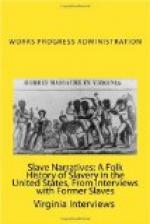Personal History of Informant
1. Ancestry—Grandmother, Spanish; Grandfather, Negro; father, Negro.
2. Place and date of birth—Born about 1846
3. Family—
4. Places lived in, with dates—
5. Education, with dates—
6. Occupations and accomplishments, with dates—
7. Special skills and interests—
8. Community and religious activities—
9. Description of informant—Tall and straight. He is blind. Clean in appearance, dressed in slightly faded overalls. He has short, clean, grey beard. Speaks with a clear accent.
10. Other points gained in interview—Ancestors were in De Soto expeditions.
Text of Interview (Unedited)
“From my mother’s mother I learned that on my mother’s side my ancestor came with De Soto from Spain where she was educated at Madrid. From Spain she came to Havana, Cuba, and from there to Tampa, Florida. From Florida she came to some point in Alabama. From this place she came to the Mississippi river and the East Bank and crossed where it is called Gaines Landing. After they crossed the river they went ten kilometers from there, traveled north from there to where Arkansas County is close to the mouth of the Arkansas River. Here they camped awhile. When they broke camp there they traveled northeast to Boiling Springs. Making their way from here they crossed the Ouachita River on the other side of Arkadelphia. They traveled on, crossing Little Missouri River below Wallaceburg. Here they found some Indian mounds. Then they traveled on a trail from there to Washington, turned into Washington and took a trail toward Columbus and turned off to the right (Uncle Bob not sure of the name of this trail) and crossed what is known as Beard’s Lake. They crossed Little River at Ward’s Ferry and crossed the Saline river. Traveling northwest they reached White Oak shoals where Index is now and crossed over into what was Mexico and traveled to a place called Kawaki located where [TR: ?] now is.
“After camping here for a while they came back into Arkansas to some point near Rando, crossed Red River at Dooley’s Ferry, went to Coola Fabra(?) and back to Boiling Springs. [Here a gold mine was found and a quarrel ensued, and in a fight De Soto was killed.] They carried his body overland and buried him in the Mississippi River between Grensville[HW:sp.] and Vicksburg. [TR: Moved from end of interview: De Soto was buried at the junction of the Mississippi and [??] Rivers, about 100 miles south of Vicksburg.] The remaining forces of the expedition returned to Spain.
“Sometime in 1816 my mother’s mother was born. My mother’s mother was Spanish. My mother says she was well educated. Mother and her mother have Spanish mixed with Negro blood. I had a sister named Mary and a brother named John.




